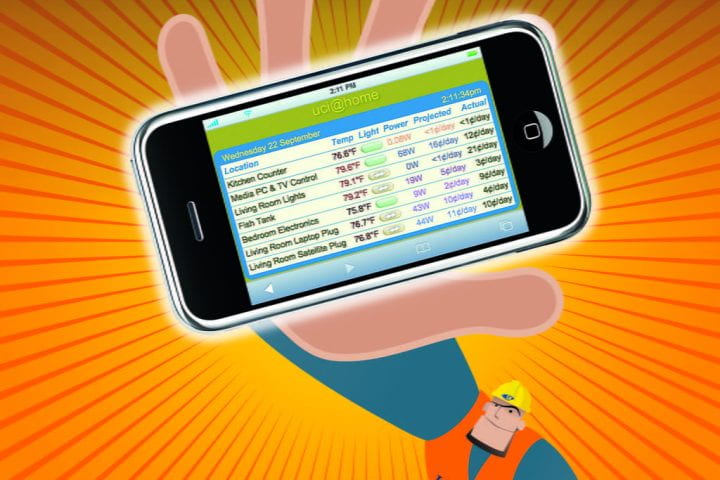What’s gobbling energy in your home?
Pilot “smart home” program shows UCI homeowners how they use energy and aims to change their habits.

Imagine being able to see to the penny how much it costs to use your jumbo high definition television or your tiny nightlight – in real time. That’s what a dozen University Hills residents did last summer as part of a “Smart Home” project aimed at reducing energy consumption.
UC Irvine researchers David Kirkby and Daniel Stokols think consumers should be able to see the cost of using their appliances as easily as they spot grocery price tags. Their premise is that such information can help save money and reduce wasteful energy consumption. To their surprise, preliminary data show that while some participants cut electricity consumption by as much as half, others who were already energy misers increased theirs slightly.
“This is not purely an engineering problem,” says Kirkby, a physics professor who launched the uci@home project. “It’s people like you and me who consume energy, it’s not the things you plug into the wall.”
They are now analyzing whether the pilot program paid off, and have applied for funding from the California Energy Commission to continue their research. Kirkby designed the system’s electronics, while Stokols, professor of social ecology, suggested effective feedback mechanisms. They believe this point-of-use information – systems that blink red, yellow or green, whir, hum and otherwise interact with the user – can effectively alter ingrained behavior.
“Once consumers are aware of their energy use patterns, they have a better chance of changing them,” Stokols says.
The sunny living room of Sergey Nizkorodov’s two-story home in University Hills houses a desktop computer, 22-inch monitor, ceiling-mounted projector, surround-sound equipment and a DVD player. Had you visited last summer, you might have noticed all the equipment plugged into a single power strip, not unlike media components in homes across the country.
The strip in Nizkorodov’s home, however, was “smart,” feeding data wirelessly every three seconds to a household hub. There, it was aggregated, graphed and stored along with the data from five other identical setups. Interactive strips blinked different colors depending on energy usage, the room temperature and lighting. Occasionally, they chirped and sent out musical notes as a way to communicate their message: “See how much energy you’re using!”
This feedback allowed Nizkorodov, a UCI chemistry professor, and his wife, Elena Koriakina, to better understand the nuances of their electricity consumption. However the study has not significantly changed their habits.
“If anything our electricity usage went up a bit after we learned how much more other people spend for the electricity,” he says.
That may be because he and his wife were already extremely energy conscious, spending just $30 a month. They keep the lights so low that friends complain at times.
But Joerg Meyer, who until this fall was a UCI assistant professor of electrical engineering & computer science, still misses the positive reinforcement of the green lights and descending chimes when he was being energy frugal. He readily agreed to sign on because of his $300 electric bills. He figured it might be his flat screen TV, which as part of the experiment did cause an annoyingly large red light to flash when it was on too long. But by logging on to his computer, he was able to spy the real energy hogs: the 1200 watts worth of incandescent lightbulbs he had blazing in the living room and the kitchen.
Meyer, who recently moved to the Bay Area to work at Lawrence Berkeley National Laboratory, said he has permanently altered his power habits. He uses only compact fluorescent lightbulbs, which he turns on in one section of a room at a time, and he flicks off lights when he leaves the room. As a result, he has cut his electricity bills in half. He thinks everyone should be able to log in and see how and where they’re using energy.
Kirkby says he and Stokols are intrigued by the variety of user patterns exhibited in the randomly selected pilot group. He hopes all of them will continue good habits, noting that even small changes can add up to large savings for the environment.
“If half of America’s households cut their energy usage by 10 percent, it would be the equivalent of taking 8 million cars off the road,” he says. “That’s a big impact.”

